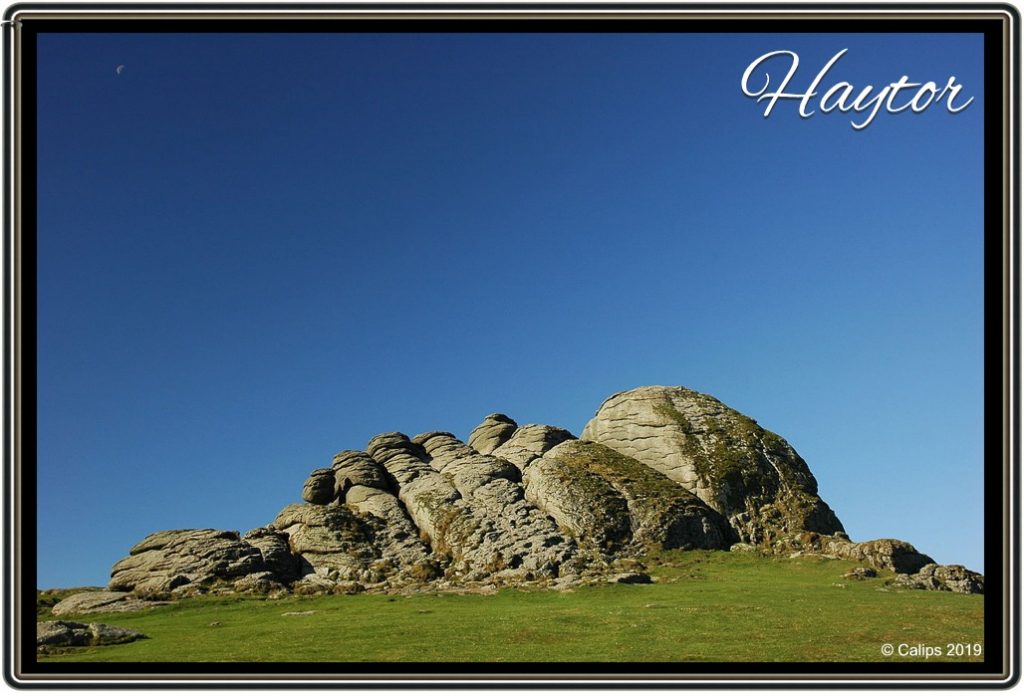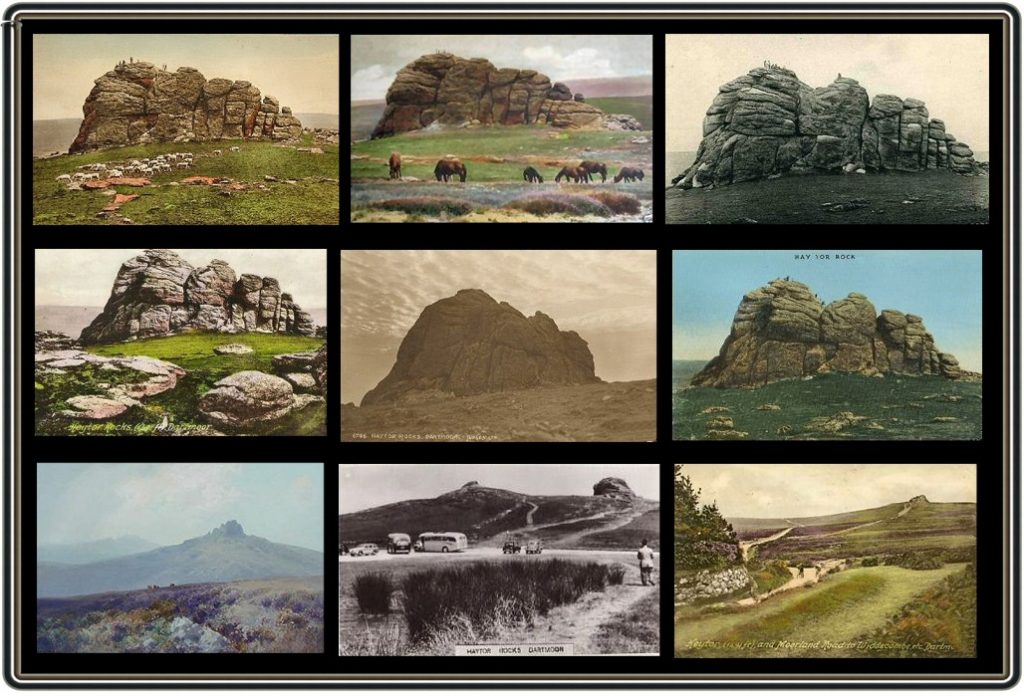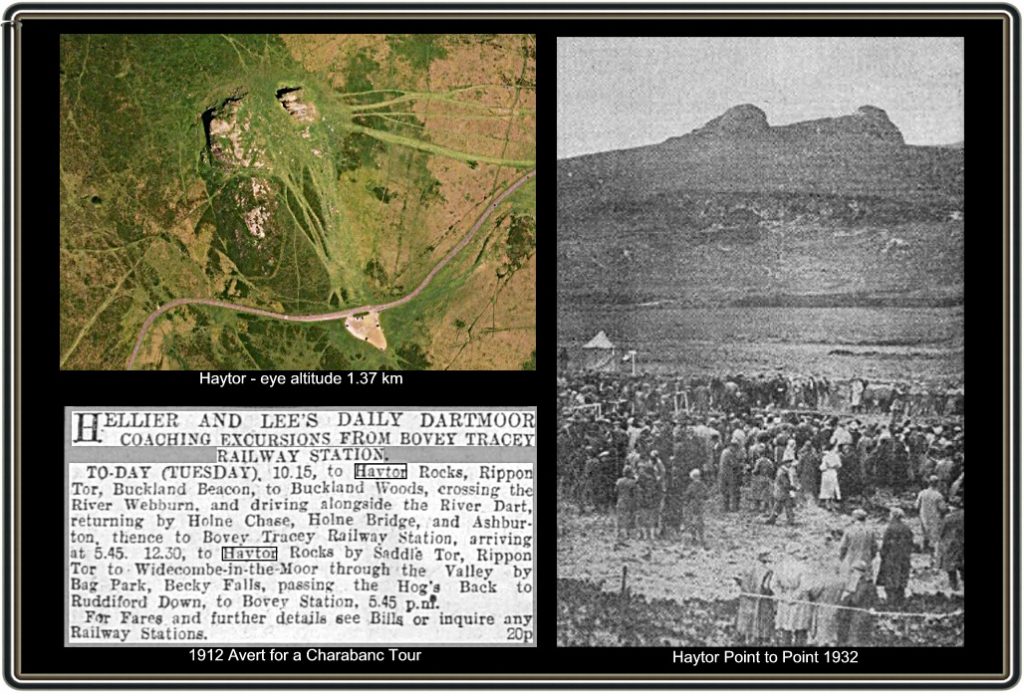
Haytor is probably the most visited tor on Dartmoor, its huge granite mass is and has been depicted on numerous postcards, sketches, paintings and photographs. Visit the tor on any day and you will find numerous coaches who include it on every tour of Dartmoor. But this is no new phenomenon because in 1895 Page, p.218 writes how: “Hey Tor, which derives its name from heah, high, is perhaps, visited more often than any other tor upon Dartmoor. This is due not only to the fact that it is easily accessible – the ‘cherrybanks’ of Bovey Tracey taking it in their round – but to the gigantic masses of rock which crown its summit, the largest piles, taken as a whole, upon the moor and the most unmistakable.”
The first mention of the tor was in 1566 when it was called Idertordoune, in a deed of 1687 the name was Ittor Doune and in the recovery rolls of 1762 and 1789 the name was Eator Down and Itterdown respectively. It is suggested that the modern place-name is corrupt and probably was influenced by the nearby hundred of Haytor with which there is no connection, Gover et al, 1998, p.476 and 505. Other moorland names for the tor are: Athur tor, Solar tor, High tor and Hey tor. Crossing considers that Athur tor was derived from Solar tor which an early writer supposed was a place where sacrifices and offerings were made to the Sun God ‘Bal’.
The outcrops of Haytor stand at 1,499 ft (457m) and consists of two granite outcrops and is classified as an ‘avenue tor’ which means that the central section of the tor has been eroded leaving an avenue running between two outcrops. The granite which makes up the tors is called ‘tor granite’ but at the base of the western outcrop is a layer of fine grained granite. Where the tor granite joins and overhangs the fine granite a ‘rock shelter’ has formed. On the top of the eastern outcrop the granite has been eroded to form a rock basin which measures roughly 34″ long, 28″ wide and 10″ deep. Sometime in the 1800’s an iron handrail was erected on this outcrop and steps were cut into it. The handrail was removed in the 1960’s and never replaced. Hemery, 1983, p.693 notes a delightful remark made by a Doctor Coker in 1851 when he said “…the unsightly stair step to enable the enervated and pinguedinous scions of humanity of this wonderful nineteenth century to gain the summit.” Which I think basically means that the handrail allowed the tired, fat heirs of the nineteenth century to gain easy access to the tor.
Why it is so popular is hard to work out as there is no special reason for its popularity apart for the proximity to the road. Admittedly there are some fine views from the top which encompass moor and coast alike and there is a lot of industrial archaeological features to be found nearby but these normally go un-noticed by the average visitor. However, ever since the time of the ‘Tommy Tourist’ in the late 1800s numerous ‘tour operators’ ran their very popular charabanc excursions and Haytor was a popular stopping off point. The tor soon became one of the ‘must see’ sights on Dartmoor with large parties enjoying the climb and views and very often having picnics on and around its mighty granite mass. In 1902 there was quite a stir when it was announced that the nearby sporting estate of Leighon was to be sold which included the famous tor. One newspaper article read; “The sporting estate of Leighon in the parish of Manaton, Dartmoor, included in which are the far-famed Haytor Rocks is announced to be sold by public auction on July 24th. A great part of the estate is enclosed land, but there is another large portion which is unenclosed, over which there are common rights. The announcement of the sale will no doubt cause Dartmoor lovers – and their name is legion – to fear that the open portions may be enclosed.” The East and South Devon Advertiser, 5th July, 1902. Should the enclosure happen that would mean public access to the tor would be denied. As announced the auction was held on the 24th of July under the auctioneers – Messrs. Frank, Knight and Rutley. It seems the bidding was brisk and in the end the estate was sold to the successful bidder, Mr. Washington Singer for £9,500.
Another popular event that was staged at Haytor was the South Devon Harrier Hunts point-to-point races. As can be see below it was a popular occasion with many hundreds of spectators there to watch. The meeting below was held on the 9th of May, 1932 and just after the photograph was taken a heavy snowstorm blanketed the down. There also was something of a stir due to the £5 car parking charge, many people complained that as it was located on a common nobody had the right to charge as it was open to public access.
When ‘Widecombe are plucking their geese’ or in other words it’s snowing Haytor comes host to numerous people coming to play in the winter wonderland. One such occasion being the 12th of March 1935 when the Western Morning news reported that; “Residents and visitors in the vicinity of Haytor indulged in sleighing on the slopes of the Moor yesterday.” As so has been the case whenever Haytor dons a mantle of snow, in 2019 there was absolute chaos at Haytor due to the fact that hoards of cars were simply parked anywhere along the narrow road. Such was the grid-lock that it took an ambulance over an hour to reach a visitor who had injured himself on the tor, best not ask where he parked his car?
There are very few legends associated with Haytor apart from the ‘Haytor Wedding Gown’ which for such an impressive rock pile is strange. This is the tale of a young woman who was forced into an arranged marriage despite loving another man. So on her wedding day, dressed in her bride’s dress she climbed to the top of the tor and flung herself off. If you want to get the rest of the story just follow the link. Sadly in the July of 2013 there was a real tragedy at Haytor when a young mother and her son also leapt of the tor which in both cases proved fatal.
Today, as previously mentioned, Haytor rocks is one of the Dartmoor ‘honeyspots’. Not only is it popular with visitors it is also popular with rock climbers with climbs ranging from 30 – 50ft such as ‘Zig-Zag’, ‘Athos’ and ‘Bulging Wall’. Over recent years the area has suffered from erosion due to the number of feet tramping up and down from the tor. The aerial photograph above clearly shows the distinct paths and tracks that have been eroded in the area, such is its popularity. For comparison the line running diagonally from the south to the north-east is the B3378 road that runs from Bovey Tracey to Widecombe-in-the Moor. As can be seen above, in some places the eroded tracks are wider than the two lane highway. In 1953 the area was used as a location for the film ‘Knights of the Roundtable’ which starred Robert Taylor and Ava Gardner. During the millennium celebrations a beacon fire was lit on Haytor rocks by the parishioners of Islington in which parish they lie. Recently Haytor has reached the national headlines as some bright spark is campaigning to get a stair lift installed at the rocks to enable disabled access. And in July the Devon’s contribution to the BBC’s ‘Big Dance’ took place on and around the tor. Around 400 people turned up to perform a specially choreographed dance to the accompaniment of a troop of Taiko dancers. Now doesn’t that lift your heart unto the heavens, I bet they couldn’t get 400 people to turn up to a litter-picking event?
To the north west lies Holwell Quarry and to the north-east lies Haytor Quarry both were in use during the 1800 – 1900’s. The more famous of the two is the Haytor Quarry. It was from here that granite was taken for use in building the famous London Bridge with rock used in the west face and the flagstones, Ewans, 1966, p.21. It is also from Haytor Quarry that the ‘Granite Tramway’ runs to Teignmouth. This tramway was designed to carry granite from the various quarries in the Haytor area and take it to Teignmouth for shipping. Work on construction first began in 1776 and was built by George Templer. The route of the old tramway is now a recognised walk called the ‘Templer Way’ and both the walk and the history of the tramway can be found on an excellent website called ‘The Templer Way’.
Bibliography,
Ewans, M. C. 1966 The Haytor Granite Tramway and Stover Canal, David & Charles, Newton Abbot.
Gover, J. E. B., Mawer, A. & Stenton, F.M. 1998 The Place-Names of Devon. The English Place-Name Society, Nottingham.
Hemery, E. 1983 High Dartmoor, Hale Pub., London.
Page, J. Ll. W. 1895 An Exploration of Dartmoor, Seeley & Co., London
 Legendary Dartmoor The many aspects past and present of Dartmoor
Legendary Dartmoor The many aspects past and present of Dartmoor




Hello Tim,
I must be doing something wrong, because The Templer Way website doesn´t offer practically any information at all, except about Stover Country Park. Very disappointing.
However, I would like to congratulate YOU on your Legendary Dartmoor website. Enjoy very much reading it and learning from it – whilst we ramble around with my husband and our grey-HOUND 🙂 Thank you!
Milena
Hello Tim, I remember being very cross that i wasn’t allowed to climb Haytor as a child when my 2 big brothers were. We always went to see it every year as we were camping in Bovey Tracey on our family holiday. I did eventually climb it & was suitably “blown away” by the whole experience. I love everything about Haytor & it’s surroundings especially the Darmoor Ponies, the space & the way everything was just random & natural. I don’t suppose it’s like that so much now. Your aerial photo shows me that where we used to pull off the road, onto a place only big enough for about 7 or 8 cars & natural rough granite stones/gravel, is now much, much larger (unfortunately). I do remember bits of the handrail being visible. A return visit to North Devon is on my bucket list & Haytor is a must. Thank you Tim, for reminding me of our holidays over 50 years ago.
Great joy for me to read this information – am looking forward to searching your website later. My life started at Pinchaford, below Haytor some eighty years ago, although most of it spent in Queensland, Australia. I loved especially the moorland area to which one could ride from home and look forward to reviving memories with your writing.
The Tor Bus Company (Which has a fascinating history and ‘out there’ are possibly still Booklets describing the Company’s History – full of local historical interest items for that area of the Moor) provided public transport to the Point to Point meetings held at Haytor but I am trying to pinpoint where the event exactly was held and over what period of time. Was it on Common Land as is suggested in the booklet.
Any further information relating to the Haytor Point to Point appreciated.
Thanks
Richard Holladay Cobntact details on the About Me page at http://www.exeterfoundry.org.uk